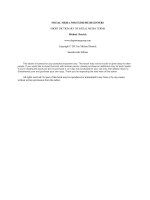Business Across Cultures Culture for Business Series_1 potx
Bạn đang xem bản rút gọn của tài liệu. Xem và tải ngay bản đầy đủ của tài liệu tại đây (1.48 MB, 25 trang )
For Hasan Ozbekhan
Because he started to give us the essence of organizational and
system thinkingCopyright © 2003 by Fons Trompenaars and Peter Woolliams
The right of Fons Trompenaars and Peter Woolliams to be identified as the
authors of this work has been asserted in accordance with the Copyright,
Designs and Patents Act 1988
First published 2003 by
Capstone Publishing Ltd (a Wiley Company)
The Atrium
Southern Gate
Chichester
West Sussex PO19 8SQ
England
www.wileyeurope.com
All rights reserved. Except for the quotation of short passages for the
purposes of criticism and review, no part of this publication may be
reproduced, stored in a retrieval system, or transmitted, in any form or by any
means, electronic, mechanical, photocopying, recording or otherwise, without
the prior permission of the publisher. Requests to the publisher should be
addressed to the Permissions Department, John Wiley & Sons Ltd, The
Atrium, Southern Gate, Chichester, West Sussex PO19 8SQ, England, or
emailed to , or faxed to (+44) 1243 770571.
CIP catalogue records for this book are available from the British Library and
the US Library of Congress
ISBN 1-84112-474-5
Typeset by Forewords, 109 Oxford Road, Cowley, Oxford
Printed and bound by T.J. International Ltd, Padstow, Cornwall
This book is printed on acid-free paper responsibly manufactured from
sustainable forestry in which at least two trees are planted for each one used
for paper production.
Substantial discounts on bulk quantities of Capstone Books are available to
corporations, professional associations and other organizations. For details
contact John Wiley & Sons: tel. (+44) 1243 770441, fax (+44) 1243 770517,
Contents
Introduction 1
1 The organization as a cultural construct 11
2 The organization of meaning: introducing value dimensions 23
3 Further value dimensions 61
4 Corporate culture 99
5 Managing change and continuity across cultures 153
6 Marketing across cultures 181
7 Managing HR dilemmas across cultures 239
8 Finance and accounting across cultures 273
9 The quest for a new paradigm of international leadership 291
10 The reconciling organization 315
Notes and bibliography 349
Index 353
v
INTRODUCTION
INTRODUCTION
A
s business becomes more global and the workforce ever
more diverse, the issue of “culture” becomes increasingly
important for leaders and managers and their organizations.
Of course many researchers and authors have already written about
culture. Models and frameworks have been developed and
described, ranging from early anthropological investigations
through to studies of national and organizational culture. However,
most existing works have tended to focus on knowledge of cultures.
This book, and others in the series, is concerned with knowledge for
cultures, and provides a new conceptual framework for dealing with
the business implications of culture. Our aim is to provide a practical
toolkit for managers and leaders by helping them develop a new
mindset for working with and across cultures. As readers will dis-
cover, there is an entirely different logic flowing throughout this
book, one breaking away from traditional management texts which
are often overly influenced by Anglo-American research and think-
ing.
The readers of our previous books and publications, together with
audiences from conference presentations, have told us that they
need an organized body of knowledge beyond simple recognition of
cultural differences in a business context. The advantage of the ear
-
lier works was that they helped managers structure their own
experiences and understand that they were seeing the world not as it
is, but from the perspective of who they were. Increasingly, however,
they have demanded a generic-solution framework to help them
develop their cross-cultural competence, and enable them to be
more effective in doing business and managing across cultures.
The new thinking and knowledge presented in this book has
resulted from a synergistic mix of a number of sources. The first is
our own rigorous research. This has included fundamental, applied,
3
and strategic research conducted by our team and extended net
-
work, one that has included many PhD students. Then there is our
own multi-cultural consulting practice, Trompenaars Hampden-
Turner, which has a diverse range of interventions across the globe.
We have enjoyed and benefited from collecting, analyzing, and
working with leaders and managers on many “real world” critical
incidents and cases that owe their origin to culture. And, not least,
we continue to monitor and evaluate the work of other authors to
validate and triangulate with our own work, although we would
claim that their solutions to dealing with cultural differences are
limited.
In our previous publications we have emphasized the importance of
having sound models to structure and explain the complexity of the
multicultural world that surrounds us. In our previous work we
have initially helped managers to recognize that there are cultural
differences, helped them perceive their importance and understand
how they impact on main business processes. In Riding the Waves of
Culture, a conceptual model based on seven bi-polar dimensions
was used to represent the diversity of values. In Seven Cultures of
Capitalism, we applied this framework to seven major national
themes in order to make capitalism meaningful. In 21 Leaders for the
21st Century, we explored the cultural dilemmas faced by leaders in
large international organizations.
However, we were aware that, like many other cultural models that
have been published since, these tools were seeking to model cul
-
tures across the world by scoring them on bi-polar scales. For such
cultural profiling tools, each dimension is based on the single-axis
continuum. When seeking to apply this sort of typology, or indeed
any other associative model in an international context, we find that
being restricted to the extremities of each scale is constraining. The
4
BUSINESS ACROSS CULTURES
fundamental limitation of such models is that it is implicit that the
more a culture tends to one end of a bi-polar dimension, the less it
must tend to the other. What if we need to consider the possibility of
both extremes being present in a single culture?
Increasingly we have found limitations to classifying cultural differ
-
ences in this way – especially when trying to help managers and
leaders deal with these differences. As much as anything, bi-polar
models often produce stereotypical descriptions that fail to explain
many facets of the actual culture they are trying to represent.
So we might hear comments like this:
“Obviously the Japanese are not creative! They are highly communitarian
and they don’t dare to stick their necks out, as they are worried about jeop-
ardizing their team spirit,”
or this:
“Now I understand why the culture in the US breeds all these lawyers.
They have become so universalistic because they need rules that govern
their individualistic relationships,”
and this:
“What’s more, their specificity has to do with the fact that they’re so mobile.
They don’t have time to develop relationships they trust. So lawyers and
their specific contracts take their place.”
What about the following explanation of the French and Italians?
“Isn’t it amazing how relaxed they are with appointments and deadlines?
They turn up 20 minutes late and don’t even bother making an excuse!
They can do things in parallel, they’re from synchronic cultures, while we
North-West Europeans are sequential. We’d rather wait.”
5
INTRODUCTION
This has been the unintended consequence of mapping cultures
with linear models. The quantitative support and exhaustive statisti
-
cal analysis gave these the scientific flavor that the 70s and 80s
business communities wanted. Let us recall that in those times the
Anglo-Saxon business model was so dominant that showing cul
-
tural differences, and the consequences for the application of
Anglo-Saxon models, was thought to be a great step forward.
So how did this thinking develop to try to explain why the French
couldn’t cope with the matrix organization or that the Japanese were
unlikely to take MBO (management by objectives) seriously? In fact,
very little. Hofstede, for example, wrote article after article to
“prove” that cultures were dissimilar – to the point where this
impeded the development of alternative thinking and constrained
the understanding and development of Anglo-American business
theory. But he was a pioneer and we shouldn’t blame him. It is rather
his followers, blindly citing his work, who should be those getting a
warning memo. Too many academic studies and publications have
followed this linear thinking, trying to prove that there are cultural
differences and that they affect the applicability of standardized
business practices. We have found that since the mid-90s there has
been an increased need to develop an alternative logic and over
-
come the limitation of this outdated thinking.
Through this Culture for Business series we want to offer an alterna
-
tive to simply recognizing cultural differences and develop ways of
crossing these differences and thus satisfying the many requests
from our clients and readers. They have suggested several main
areas that we will summarize in this book, but which will be
extended one-by-one in the full series.
We have also developed a new set of tools to capture cultural differ
-
ences in an alternative paradigm that overcomes the limitations of
6
BUSINESS ACROSS CULTURES
the linear bi-polar models. The new logic is largely explained by the
theory of complimentarity – that no value can flow if it lacks a ten
-
sion with its opposite. Traffic lights stuck on red and green don’t
help traffic negotiate a junction – only the constant changing
through the red-amber-green cycle sustains the system. If individu
-
als are disconnected from the community, they become egoists. If the
community isn’t in contact with individuals, we could speak of com
-
munism. And both egotism and communism (on their own) do not
seem to work in the long run.
RECOGNIZE, RESPECT AND RECONCILE
Back to school now, but with our three R’s. This is the essence of our
new approach based on the need to Recognize, Respect and then
Reconcile cultural differences. The reader will be aware of the first
requirement to recognize cultural differences. At least the earlier
models have achieved that and help managers avoid being
ethnocentric. Accepting the theory of complimentarity is the begin-
ning of the next step, which is to respect cultural differences.
As supported by our extensive research evidence, all values are fun-
damentally within each of us but they manifest themselves as a
series of dilemmas. While the dilemmas themselves are beyond cul
-
ture, the way people approach and resolve them are culturally
determined. Respect starts from within. Once you know there is
something “Japanese-like” in you, but that it is your own culture
inside your head which silently whispers this to you, this is where
respect starts.
Fons writes:
I remember that I was in love with a girlfriend (now my wife, obviously). It
was 25 years ago and we were spending a weekend in London. One Sunday
7
INTRODUCTION
morning, she showed me a dress that she had bought the day before and
asked what I thought of it. She added that she had bought it to please me.
The dress, in my opinion, was awful, but I told her that I liked it. Doesn’t
this sound familiar? When we’re in love an honest “no” becomes a tactful
“yes.” We suddenly realize that we are partly Japanese. But in the Nether
-
lands, we have to be in love to have a relationship prevail over an opinion
about a material object.
Peter adds:
In turn, the British would say “interesting” to indicate their disgust.
It is very difficult to realize that we are being ethnocentric far too
often.
Did you hear about the man who wanted to take his kids to the local swim-
ming pool one Saturday afternoon, so he telephoned first to check whether
they were open? When the telephone was answered, he asked if he was
speaking to someone at the local swimming pool. “Well, that depends on
how far away you are,” said the voice at the other end.
Once you are aware of and respect cultural differences, the way is
open for the third step, which is reconciliation. We often hear that the
world of business and management does not need more proof that
people are difficult. The question now is to ask what we can do with
the differences to make our businesses more effective once we cross
cultural or diversity boundaries. Reconciling cultural differences is
the answer.
This book and other titles in the series will all explicitly and/or
implicitly follow the same three steps of recognition, respect and rec
-
onciliation. While this first book describes the common model across
all the major disciplines, the functionally specific books that follow
8
BUSINESS ACROSS CULTURES
will cover areas in much more detail, with more cases and examples
for the specialist.
First, we will consider how culture pervades business and then look
at this from both national and organizational perspectives. In sub
-
sequent chapters, we will demonstrate how our general model is
applied to Marketing, Accounting and Finance, Human Resource
Management and leadership. We will conclude with our paradigm
of the reconciling organization, in which the principles we discuss
are embedded in both the mindset and actions of leaders and their
organizational systems.
You will find more information and material at the series’ website:
www.cultureforbusiness.com.
9
INTRODUCTION
CHAPTER 1
The organization as a
cultural construct
THE ORGANIZATION AS ACULTURAL CONSTRUCT
I
n order to explore the future for global business, we should first
reflect on where the past has brought us. When we look at work
that was done in the late nineteenth century and at the beginning
of the twentieth, we can clearly see how social theory in general and
organization theory in particular have attempted to explain the
developments that the industrial revolution had initiated.
Among the grand theories that have stood the test of time, we find
the works of Durkheim, Tönnies and Weber that seek to explain
large societal developments. Emile Durkheim focused on the transi-
tion from mechanical to organic solidarity as a result of the division
of labor. Ford Tönnies observed a movement from Gemeinschaft to
Gesellschaft, while Max Weber discussed the unavoidable evolution
of the bureaucratic “ideal type” as a logical conclusion of the “spirit
of Protestantism.” In the field of organization theory, we can see seri-
ous efforts by Taylor and Fayol to find reliable, reproducible and
transferable principles that would help management and workers to
become more efficient. Frederick Taylor is credited with developing
Scientific Management (although he never used this term to describe
what he called “managing scientifically”) and his account of the
Pennsylvania Dutch is well known. By simply observing move
-
ments of physical labor and advising workers how to become more
efficient, productivity was significantly affected. In parallel, atten
-
tion was given to effective systems of variable pay, so that workers
were motivated to apply more efficient work methods. Henri Fayol
focused on organizational structure, looking at things like the most
ideal team size and the optimal “span of control.” However, the
assumption on which these ideas were based is clearly that of a
purely rational individual – an “actor” – in a closed organizational
system.
13
With increasing organizational efficiency, growth was spectacular.
So much so that private owners had to go public, not simply because
the stock market was now a fact, but because the split between
ownership and management developed. A new shareholder logic
was introduced which kept the individual rational but opened the
organizational system. Simultaneously, Scientific Management
continued to experiment on how one could increase worker produc
-
tivity by changing “hygiene factors” such as the intensity of light in
the work environment. The so-called Hawthorne experiments on
this led to results which surprised the theorists: people did not oper-
ate like mechanical systems. From this, Elton Mayo and Dick
Roethlisberger, the two main experimenters, started what was to
become the Human Relations School. Workers were more motivated
by the fact they got attention and felt part of an elite than by the level
of the lighting on their work bench. This opened up new attention to
the actor as a full social individual, in sharp contrast to the
uni-dimensional, materialistic, rational actor that was assumed to
exist under the Scientific Management School.
However, organizational systems and thinking remained far too
closed. Many social psychologists of the 1950s followed similar
assumptions. Unfortunately these models are too often cited by
more recent writers seeking to legitimize their own commentaries.
Motivational Scope Organizational System
Closed Open
Rational
ț
Scientific Management
(strictly “managing
scientifically”)
ț
Functionalism
ț
Early Systems Theory
ț
Contingency Theory
Social
ț
Human Relations School
of Social Psychology
ț
Modern Systems Theory
ț
Symbolic Interactionism
ț
Chaos Theory
14
BUSINESS ACROSS CULTURES
Functionalism and systems theory as methodologies were devel
-
oped to obtain better insights into the interaction between the
organizational system and its environment. By considering an orga
-
nization as an open system and introducing concepts such as input,
output, feedback, and lag, many new linkages were discovered to be
in need of attention. Systems jargon – like Entropy, the Principle of
Equifinality, and the Law of Requisite Variety – was introduced or
copied from other disciplines. Writers like Parsons, Merton, and von
Bertalanffy were criticized because they looked at an organizational
system in the same way that a natural scientist would look at a mole
-
cule. The systems movement culminated in the Club of Rome
(Limits to Growth) which predicted the end of the economic world
from the vicious circle of growth producing waste and deplenishing
raw materials. Today, a version of this open systems approach is still
very popular; for example, look at contingency theory. This has
some following because it has been subject to critical and rigorous
research by academics such as Harvard professors Paul Lawrence
and Jay Lorsch. Essentially contingency theory was a revenge and
counter-argument to the “one best way of organizing” so implicit in
Scientific Management. Contingency theorists like Derek Pugh and
Paul Hickson (the so-called Aston Group of researchers) demon
-
strated that optimal organizational structure was contingent upon
main environmental characteristics such as the inter-linkage
between technology and market.
Lawrence and Lorsch found significant correlation between the
degrees of differentiation and interpretation of organizational pro
-
cesses in industries that were operating in different environments.
Others found relationships between the number of hierarchical lev
-
els and the complexity of technology. Attempts were made to
quantify the cause-and-effect relationships of environmental factors,
such as complexity of market and technology by using R&D expen
-
15
THE ORGANIZATION AS A CULTURAL CONSTRUCT
diture/turnover ratios or the average life span of a product. The
search was on for variables, co-variables, and transfer (input–out
-
put) functions. In turn, the structural characteristics of an organiza
-
tion were quantified through counting hierarchical levels and the
average span of control. In some cases, scores of job-evaluations
were entered into computer manpower planning models. And
indeed, the claimed optimal organization structure was dependent
on those quantifiable environmental characteristics that could be
modeled!
The motives for such research and claimed findings were varied.
Thinking often followed the notion that if the optimum organization
structure could be designed and implemented, then a lean, efficient
organization would enable management to deliver the sharehold-
ers’ goals. And in this optimal organization, management could
motivate and control the work force in order to deliver the results if
they knew which levers to pull (or push) – levers such as pay for per-
formance.
Let us remind ourselves once again that most of this published
research, the host organizations in which the research was under-
taken, and the researchers themselves were Anglo-American – or
were at least dominated by such thinking. But then came a quantum
shift: the beginning of globalization during the 1970s.
Organizational theorists added the cultural factor. Studies were con
-
ducted in large multinational role-driven organizations, like Shell
and IBM, operating in global markets. The immediate advantage of
such market settings was that factors such as financial, technologi
-
cal, and market conditions were similar since the companies sold
global products. In fact, the only significant difference was the cul
-
tural environment in which the company operated. Some early
results at the time showed that the cultural factor was an insignifi
-
16
BUSINESS ACROSS CULTURES
cant influence on the way the organization was structured –
especially where the HQ or parent structure had been exported
without any local adaptation. It was commonly held that “the orga
-
nization is (national) culture-free” and in some regard this is still
evident from our consulting practice today – more so than one might
expect.
Fons remarks:
In my earlier career at Shell, while I was doing my PhD, I clearly
remember my encounter with the Dutch General Manager of the
refinery in Singapore. I asked him how the refinery had adjusted
itself to Singaporean culture. He immediately asked whether I was
working with Personnel! Indeed at the time I was, so he invited me
into the real world of management and gave me a tour. Amid the
whispering of steam from hot metal, he asked me if I could under-
stand that “things could not easily be adapted to Singaporean
culture. If Singaporeans do not like working in shifts, can we simply
adjust our approach? Obviously not.” Cynically enough, this
revealed that the way the organization was set up was very similar
to the refinery in Rotterdam-Pernis. In fact the organizational
schemes were developed there and “exported” to Singapore, even
including the descriptions for the large majority of jobs. In short, the
technology of production was so dominant that culture was deemed
irrelevant.
What about the financial analysts or market traders of today and
their approaches? When they cut a deal for a merger or acquisition,
do they ever raise the possibility of a cultural misfit in the organiza
-
tions they marry? No, because the financial factor dominates. This
was well illustrated by one analyst who whispered to us: “We are in
the business of weddings, not in long-term marriages!”
17
THE ORGANIZATION AS A CULTURAL CONSTRUCT
So why the Culture for Business series? Both in theory and in prac
-
tice, culture is a factor that, unlike technology, market or financial
conditions, cannot easily be quantified or shown to be a major causal
variable. And yet the greatest management thinkers and practitio
-
ners keep on bringing up this subject of culture. How come? What is
the fallacy in the existing debates on culture? What is the limitation
of the logic within which these conclusions have been drawn? We
offer an answer.
CULTURE AS THE CONTEXTUAL ENVIRONMENT
Although the preceding arguments sound very logical, they are only
logical within an illogical system. The assumptions on which these
perceptions of reality are based come straight from the natural sci-
ences. The quest was for scientific rather than ontological truth. The
Contingency School also interpreted reality as scientists would study
cells. There were no alternative ways of imposing meaning on what
was observed. It was Alfred Schutz, the phenomenologist, who said it
so clearly: “The advantage of a natural scientist over a social scientist
is that atoms and molecules don’t talk back.” The researcher has often
taken the observed individual as a purely rational actor, following
exactly the same motives as the observer would follow. This is not
only true for the definition of the environment but for the interpreta
-
tion of organizational structure as well. Let us return to the definition
of complexity of the technology in use or to the number of hierarchi
-
cal levels in the organization. The former was defined by indices or
ratios such as R&D/Turnover. If we were to ask a modern teenager –
without a calculator – what the square root of 144 multiplied by 13
and divided by 10 was, they might well answer that the sum was
impossible for them to solve. In contrast, a third year math student
might laugh about its simplicity. What is complex and/or makes
things complex?
18
BUSINESS ACROSS CULTURES









